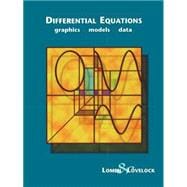
What is included with this book?
David O. Lomen is the author of Differential Equations: Graphics, Models, Data, published by Wiley. David Lovelock is a British theoretical physicist and mathematician. He is known for Lovelock theory of gravity and the Lovelock's theorem.
| PREFACE | v | ||||
|
1 | (26) | |||
|
1 | (6) | |||
|
7 | (4) | |||
|
11 | (11) | |||
|
22 | (5) | |||
|
27 | (54) | |||
|
28 | (8) | |||
|
36 | (6) | |||
|
42 | (11) | |||
|
53 | (12) | |||
|
65 | (10) | |||
|
75 | (6) | |||
|
81 | (38) | |||
|
81 | (13) | |||
|
94 | (3) | |||
|
97 | (15) | |||
|
112 | (3) | |||
|
115 | (4) | |||
|
119 | (64) | |||
|
119 | (17) | |||
|
136 | (9) | |||
|
145 | (13) | |||
|
158 | (9) | |||
|
167 | (8) | |||
|
175 | (8) | |||
|
183 | (40) | |||
|
183 | (13) | |||
|
196 | (15) | |||
|
211 | (12) | |||
|
223 | (56) | |||
|
223 | (8) | |||
|
231 | (10) | |||
|
241 | (9) | |||
|
250 | (9) | |||
|
259 | (7) | |||
|
266 | (6) | |||
|
272 | (7) | |||
|
279 | (36) | |||
|
279 | (4) | |||
|
283 | (11) | |||
|
294 | (21) | |||
|
315 | (64) | |||
|
315 | (8) | |||
|
323 | (7) | |||
|
330 | (6) | |||
|
336 | (7) | |||
|
343 | (7) | |||
|
350 | (5) | |||
|
355 | (13) | |||
|
368 | (11) | |||
|
379 | ||||
|
379 | (9) | |||
|
388 | (15) | |||
|
403 | (5) | |||
|
408 | (5) | |||
|
413 | (17) | |||
|
430 | ||||
|
315 | ||||
|
437 | (11) | |||
|
448 | (8) | |||
|
456 | (11) | |||
|
467 | (18) | |||
|
485 | (7) | |||
|
492 | (6) | |||
|
498 | (7) | |||
|
505 | (70) | |||
|
505 | (11) | |||
|
516 | (7) | |||
|
523 | (8) | |||
|
531 | (14) | |||
|
545 | (8) | |||
|
553 | (7) | |||
|
560 | (6) | |||
|
566 | (9) | |||
|
575 | (56) | |||
|
576 | (5) | |||
|
581 | (18) | |||
|
599 | (10) | |||
|
609 | (22) | |||
| APPENDICES | 631 | (28) | |||
| A.1 Background Material | 631 | (6) | |||
| A.2 Partial Fractions | 637 | (3) | |||
| A.3 Infinite Series, Power Series, and Taylor Series | 640 | (2) | |||
| A.4 Complex Numbers | 642 | (3) | |||
| A.5 Elementary Matrix Operations | 645 | (6) | |||
| A.6 Least Squares Approximation | 651 | (3) | |||
| A.7 Proofs of the Oscillation Theorems | 654 | (5) | |||
| ANSWERS | 659 | (13) | |||
| INDEX | 672 |
The New copy of this book will include any supplemental materials advertised. Please check the title of the book to determine if it should include any access cards, study guides, lab manuals, CDs, etc.
The Used, Rental and eBook copies of this book are not guaranteed to include any supplemental materials. Typically, only the book itself is included. This is true even if the title states it includes any access cards, study guides, lab manuals, CDs, etc.